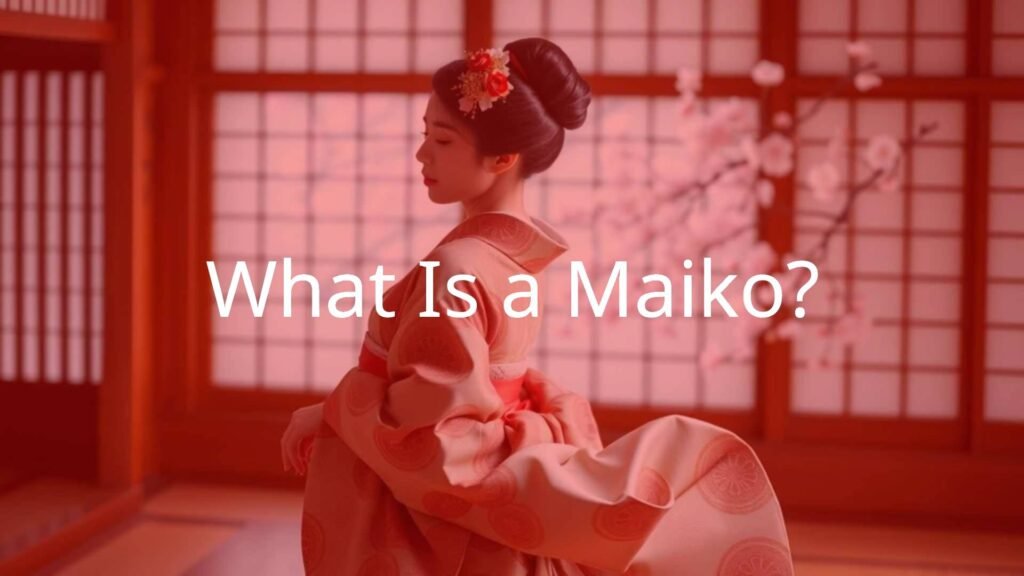A maiko is an apprentice geiko (the Kyoto term for geisha) who trains in Kyoto. These young women are not just entertainers-they commit themselves to learning and keeping alive traditional Japanese arts. Maiko perform songs, dances, and play instruments at banquets and gatherings called ozashiki, acting as a bridge to Kyoto’s cultural history.
Becoming a maiko takes hard work and involves strict training that often starts in their teenage years. It’s much more than learning how to perform; it means fully stepping into a life steeped in rules, customs, and local dialects. People are drawn to maiko not only for their appearance and talents, but for their dedication to upholding traditions that have been respected for generations.

What Does “Maiko” Mean?
The word “maiko” (舞妓) breaks down into “mai” (舞) for “dance” and “ko” (妓) meaning “child” or “girl.” So, “maiko” literally means “dancing girl,” which suits their main focus at the start of their training. This title reminds everyone that they are apprentices, still learning and growing in their skills.
The Role of Maiko in Culture
Maiko help keep traditional Japanese culture alive, especially in Kyoto. They show the grace and artistic skills that were valued in the past. At ozashiki, maiko offer guests a look at classic Japanese entertainment, mixing music, conversation, and hospitality.
They also help by wearing old-style clothes, using the Kyoto dialect, and following long-standing customs. Maiko are part of efforts to keep dances, music (like those played on the shamisen), and tea ceremonies going strong. Their work helps make sure these traditions don’t disappear.
A Look at Their History
The maiko tradition started around 300 years ago during the Edo period. At first, women served tea and snacks to visitors at Kyoto shrines. Over time, some started performing for guests, eventually leading to the development of both geiko and maiko roles. After World War II, the number of maiko dropped sharply, but today they are once again key figures in keeping Kyoto’s traditions alive.
What’s the Difference Between a Maiko and a Geisha (Geiko)?
The words “maiko” and “geisha” (or “geiko”) are often confused, but they refer to different stages of the same path. Here are the main differences:
- Maiko: Younger and still in training, usually ages 15-20. Their main job is to learn traditional arts and cultural skills.
- Geiko/Geisha: Women who have finished their training, usually aged 20 and up. They are considered skilled professionals in dance, music, and conversation.
Age and Training
Maiko usually start their apprenticeship at about 15 or 16. This training may take about 3 to 5 years. During this time, they live in a geisha house (okiya) and focus on learning dance, music, and conversation skills.
Once their training ends (usually at age 20 or older), they become geiko. These older women continue practicing their skills but are no longer supervised and can work more independently.

Appearance
| Maiko | Geiko |
|---|---|
| Bright, colorful kimono with long sleeves (hikizuri), long dangling obi (darari obi), natural hair styled with many ornaments, red collar, red and pink makeup, only their lower lip painted red if junior | More modest kimono with shorter sleeves, shorter obi, usually wear wigs, white collar, no pink blush, both lips painted red, simpler makeup |
Skills and Duties
Maiko are still learning, so their dance and music skills are developing, and they may be shy when talking to guests.
Geiko have polished their abilities and are skilled at entertaining guests through conversation and performing arts, adapting easily to what guests like.
Stages of Becoming a Maiko
The process of becoming a maiko happens in clear steps. Each phase has its own duties and lessons:

- Shikomi: Newcomers around 15 or 16 help with chores, adjust to rules, and get basic training in arts and dialect. This stage lasts about a year.
- Minarai (Learning by Watching): After the shikomi passes an internal test, she wears simplified maiko clothing and follows her seniors to events, mainly observing and learning. This lasts about a month.
- Misedashi (Official Debut): This is her formal introduction as a maiko, marked by a special ceremony and new outfit.
- Maiko Stage: The main period of being a maiko, performing and training for up to 5 years (sometimes more).
- Sakkō and Erikae: Near the end of her time as a maiko, she wears a special hairstyle, then has a “collar changing” ceremony (erikae) to become a geiko. The old hairstyle is cut, and her new status starts.
What Do Maiko Do?
Maiko mix hard study of arts with social and hosting duties. Their routine is set so that they can practice, perform, and fulfill their responsibilities as hostesses.
- Practice: Daily lessons in dance, shamisen (lute), and singing. They adjust their dances to fit the season or events.
- Entertain: Perform at ozashiki, play music, sing, and dance for guests.
- Serve: Help at teahouses, fill glasses, and learn to chat politely, even if only a little at first.
- Participate in Festivals: Join public shows and local events, such as the Miyako Odori dance festival in April.

What Do Maiko Wear?
Maiko have a very recognizable look.
Kimono (Hikizuri)
- Very long, trailing kimono with long sleeves, often bright and decorated with flowers
- For big events, a formal black kimono with five crests
- Hold up the kimono when walking outdoors to keep it clean
Obi (Darari Obi)
- Extra-long sash, about 6-7 meters long, hangs down the back, marked with the house crest
- Tied by a specialist dresser
- Shinier and more decorated for formal events
Footwear and Accessories
- High wooden sandals called okobo, sometimes with bells that ring when they walk
- Traditional split-toe socks (tabi)
- Outfit can weigh up to 15 kilograms, especially in winter with extra layers

Maiko Hairstyles and Hair Accessories
Traditional Hairstyles
- Mostly use their own hair, not wigs
- Junior maiko wear the “wareshinobu” style-split bun, often with colorful cords
- Senior maiko may wear styles like “ofuku” or special versions for festivals
- Hair is styled by a pro every week-maiko sleep on special wooden pillows to keep it neat
Kanzashi (Hair Ornaments)
- Change monthly to match the season, often shaped like flowers or plants
- Junior maiko wear more elaborate designs with dangling pieces; seniors wear simpler ornaments
Why Hairstyles Change
- Each new style marks a step forward in their training
- The biggest change comes at the end, when maiko become geiko and swap to a more grown-up look
How Is Maiko Makeup Done?
White Base
- White makeup paste is applied to the face, neck, ears, top of chest, and back
- A thin strip of natural skin is left visible at the hairline (shows they use their own hair) and a “V” shape on the back of the neck
- The base is dusted with white powder for a smooth finish
Eyes
- Black eyeliner all around the eyes with a wing at the corners
- Red is added at the inner and outer corners for extra effect, more dramatic for maiko than geiko
Lips and Cheeks
- Junior maiko paint only the lower lip red; seniors may do both, but in a smaller shape
- Pink blush on the cheeks is a sign of being a maiko (geiko usually don’t wear it)
Special Makeup
- On big days or near graduation, the makeup may change a little-for example, the lip shape or eye details
- Maiko often learn to do their own makeup over time

Where Do Maiko Live and Work?
Hanamachi (Geisha Districts)
- Maiko mostly stay in five geisha districts in Kyoto: Gion Kobu, Gion Higashi, Miyagawacho, Pontocho, Kamishichiken
- These districts have traditional streets, teahouses (ochaya), and restaurants (ryotei) where maiko work
Okiya (Geisha House)
- Maiko live together in a geisha house, run by a “house mother” (okami-san)
- The okiya provides food, clothing, housing, and training
- Strict rules: no cell phones, no money, no romantic relationships
Daily Life
- Morning to afternoon: Lessons in arts, dance school, and etiquette
- Afternoon/evening: Get ready (makeup, hair, kimono)
- Evening to late: Entertain at events and teahouses, sometimes working after midnight
Can You Meet or See a Maiko in Kyoto?
Public Shows
- Gion Corner theater puts on daily performances for tourists, including maiko dances
- In April, the Miyako Odori spring dance is a rare chance to see both maiko and geiko perform together
- Sometimes you may spot maiko in the streets, especially in the evening-but remember, they’re on their way to work
Dining or Tea Ceremonies
- Some tour companies and certain restaurants now let visitors book dinner or tea with a maiko, including performances and photos
- Costs vary, but it can be expensive; booking through a hotel or agency is usually easiest
Etiquette
- Always be polite-no touching, and always ask before taking photos
- Don’t ask personal or rude questions
- Never chase or stop a maiko on the street
Dress-up Experiences
- Kyoto has studios where you can dress up as a maiko for photos using kimono, makeup, and wigs
- This is only for fun-not the same as being a real maiko
Frequently Asked Questions about Maiko
How many maiko are there today?
There are about 200 maiko in Kyoto now. There used to be more, but the number went down after World War II and continues to be small. Each maiko is important in keeping the tradition going.
Are Maiko still respected?
Yes, maiko (and geiko) are still well respected in Japan, especially in Kyoto. People see them as symbols of tradition, art, and hospitality-not as anything else. Becoming a maiko takes hard work and skill, and their commitment gains admiration.
Do Maiko and Geiko sleep differently?
Yes. Maiko sleep on special hard pillows to keep their natural hair hairstyles in place for days at a time. Geiko often wear wigs, so they don’t need these pillows and can remove the wig at night.
What happens to Maiko after they graduate?
Most maiko aim to become geiko, continuing their careers as artists and hostesses. Some may leave the profession to get married or sometimes move into other jobs such as acting, but this is rare. Their main goal is to master traditional arts and remain a part of Kyoto’s cultural life.
- What Is a Maiko? - July 13, 2025
- What Does Domo Arigato Mean? - July 12, 2025
- What Does Naruto Mean? - July 12, 2025









